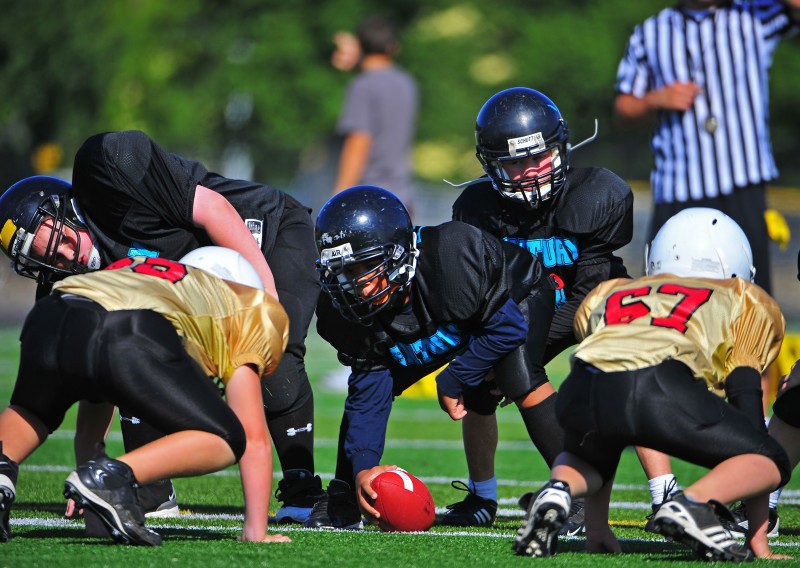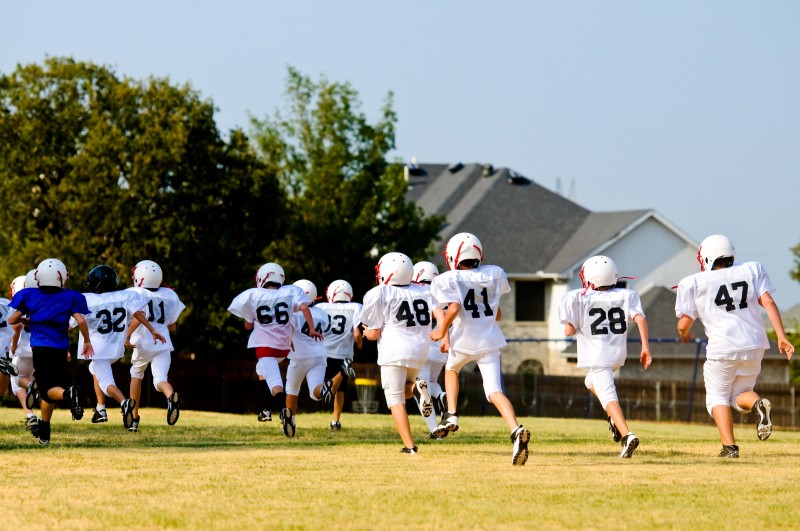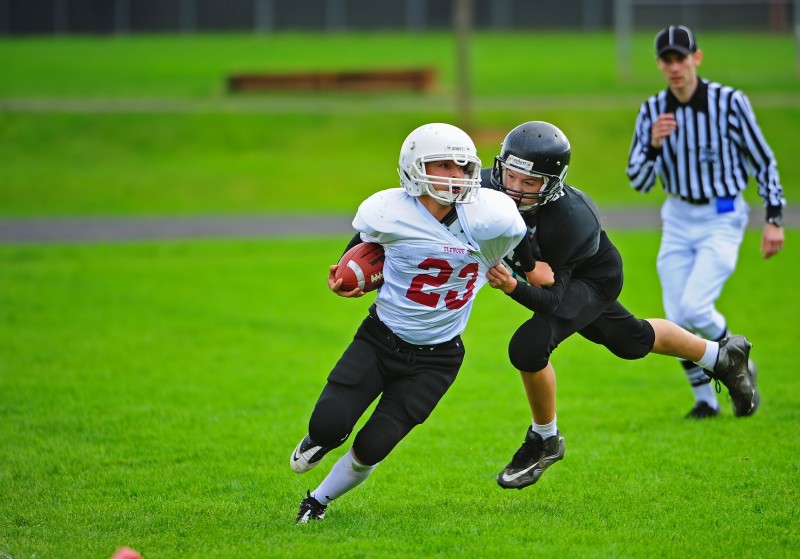
Football is America’s favorite game. Each fall, millions of people make their way to watch athletes across all levels compete in one of the most entertaining sports in the world. Although the focus of this industry is on the elite athletes at the college and professional level, the majority of athletes who play football are children.
According to the NCAA, the total number of football student-athletes across all divisions of the NCAA amounts to 73,000. In the NFL, there are 32 teams. Each team is limited to a 53-man roster, which means that there are only about 1,700 active NFL players (not including the practice squad). At the high school level, the National Federation of State High School Associations reports that 1,057,382 high school athletes participate in football each year. Pop Warner, one of the nation’s largest youth football leagues, reports 250,000 participants each year. This means that just one youth league has over three times the participants as the NCAA and NFL combined.
RECENT: The Importance of Recovery for Youth Athletes
The recent attention to brain trauma over the last 5-10 years has sparked many questions as to the safety of the sport of football. This has led to trends in youth leagues as well as in high school teams that have seen a decrease in participation over the last few years. So, the obvious question is, is it warranted? Should kids be playing youth football? Due to my position as a health care professional who works with collegiate and high school athletics programs, as well as my history of being a collegiate football player at the University of Iowa, I am often asked this very question.
Before I begin, it’s important to elaborate on the age range of the “youth athlete” to which I’m referring. Technically speaking, high school athletics is still youth. For the sake of this article, youth athletes will pertain to children under the age of 12 (6th grade).
Although I have my own opinions and perspectives, I will never tell a parent they are right or wrong for enrolling their child in a contact sport such as football. What I do recommend, however, is that parents ask themselves three important questions before putting their kid into a contact sport: Is it safe? Is it beneficial? Is it enjoyable?
Image credit: Jim Boardman © 123rf.com
Is it Safe?
Clearly, the first question that comes to mind when questioning collision sports is safety. So, is it safe for a youth athlete to play contact football? In short, yes. Youth football is safer in comparison to high school or higher competition levels of football. The reason for this is that youth athletes simply aren’t able to create and transfer force that is significant enough.
Now, this may seem contradictory to the claims you may have heard from a parent who has a kid in youth football. According to them, their kid is already running a 4.8 40-yard dash, and laying the wood like he’s Lawrence Taylor. But the reality is, kids under the age of 12 haven’t gone through puberty, which means they are weak, under-developed, and uncoordinated. Don’t believe me? Try and push one over, or have them run into you as hard as they can. Force equals mass times acceleration. A 10-year-old has neither; he is simply not the headhunter that his dad claims he is.
Prepubescent kids lack the muscle development to produce large amounts of force, and many (especially in today’s world) lack the motor control and joint stability to load and transfer what force they can produce with any significant leverage. This leads to a safer environment, as the athlete is subject to less force on each play. Even with a lack of joint stability, these kids are not creating the force that is necessary to cause some of the traumatic, non-contact injuries that can alter a career (like an ACL tear). This is why, in comparison, youth leagues are a relatively safer time to play football.
Athletes at the high school level who are going through puberty are a different story. These athletes are experiencing large amounts of growth in their bodies in a relatively short amount time and can produce larger amounts of force. This scenario creates a perfect storm for athletic injury, as the athlete can now create force but may still not be able to properly move and stabilize their joints. This is why a foundational base of strength training is so vital in both performance and injury prevention, as the focus must first be on the ability to stabilize the joint during movement and transfer force to the external environment.
Now, don’t hear what I’m not saying. Every sport has an inherent amount of risk for injury. It is important to understand that even though youth football may be safer than high school football, it doesn’t mean that youth football is completely risk-free. What really needs to be asked by the parent, is are these risks worth it?
We have already discussed that youth athletes are not generating significant force from one player to another, but this does not remove other types of force involved in football. Specifically, contact with the ground. The aforementioned lack of stability and maturity in the joints does leave a youth athlete open to ligamentous injuries and fractures of the hand/wrist and foot/ankle joints, as these are areas that are often involved with primary contact with the ground.
A fall on an outstretched hand (FOOSH) injury typically leads to a sprain or fracture in the wrist, as the athlete is trying to support themselves while being tackled or falling. Contact with the ground also has an increased risk of fracture, as growth plates are still open and the youth athlete’s skeletal structure is still underdeveloped. Ankle sprains can occur for numerous reasons. Uneven ground, or impact from another player are some of the more common causes of an ankle sprain.
The final risk that I want to bring into consideration is the risk of cumulative trauma. Some injuries to the body are not acute in nature, but rather small, isolated traumas that build up over time. The most obvious of these are Chronic Traumatic Encephalopathy, which is a neurodegenerative condition of the brain caused by repetitive traumas to the head. This is an easy example to highlight as it’s been in the news nonstop, but other degenerative conditions exist that are similarly present if an athlete spends enough time participating in athletics. These conditions include osteoarthritis, and many spinal conditions such as disc degeneration.
Another cumulative injury type are injuries that predispose the athlete to further repeated injury. The number one predictor of a future ankle sprain, for example, is a previous ankle sprain. I myself, had my first ankle sprain when I was in the third grade. I remember this for two reasons: 1) It happened on my birthday, and 2) after that first ankle sprain, I had about a dozen more over the following seven years. The ligaments in my ankles are so stretched out now, that my ankle will roll almost 30 degrees before proprioception kicks in to inform my body that my ankle is in inversion.
So, didn’t I just contradict myself? I said that these kids aren’t producing enough force to cause traumatic injuries like concussions, but then I just said that there is possible risk of furthering CTE by playing youth football. So, which is it? Is youth football safe or not? Pick one!
The question that I’m really trying to bring to light isn’t whether or not youth football is safe. Again, comparatively it is – but if your intentions are that you want your kid to play at the high school level and beyond, you should consider that the road that he will have to travel to get there will have its fair share of risks and injuries along the way. Even if the risk is minimal, why risk having that first ankle sprain at age ten, because your son got rolled up on by a kid who can barely run without tripping over his own feet, or one with horrible tackling technique? It’s a concept I call “red-shirting your body”. Just like in college a team may hold a freshman out of competition in order for him to have an extra year at the end of his career, why not save your kid’s body for later when it actually matters?
Image credit: tammykayphoto © 123rf.com
Is it Beneficial?
As I eluded to in the last section, a risk-reward analysis should be considered in order to determine whether or not the benefits of playing youth football outweigh the risks. So, what are the benefits to youth football? Very few.
At the high school level, the reward for taking the risk of playing football could be a free education or a state championship. In college, the reward could be a chance at a professional career and a national championship. At the professional level, the reward is usually millions of dollars and, if you’re lucky, a Super Bowl or Pro Bowl. But as we will explore in this section, there are very few rewards from youth football, and the rewards that do exist for playing youth football may not even be unique to contact football.
So, what are possible benefits of youth football? Skill development? Learning the game? Developing technique? And, what about getting a head start on all the other kids to get that division I scholarship?
Skill development and learning the game are absolutely benefits of playing football – but these benefits are not unique to tackle football. The positions that most benefit from youth football are skill positions such as running backs, quarterbacks, wide receivers and defensive backs. This is because so much of the skills and lessons of the game at these positions are learned through repetition. Catching requires hand-eye coordination; evading a tackler and defending against a receiver requires reaction and anticipation. Furthermore, it is never too early for a quarterback and wide receiver to learn the different passing routes and work on timing. But none of those skills require getting tackled to develop. All are just as beneficial (and safer) if learned in a non-contact, flag football league.
Positions that do not receive much benefit from youth football should not be that surprising, as these positions are universally the positions that take the longest to develop at all levels of competition. They are linebacker and offensive and defensive line positions. Development of skill, technique, and learning the game are a complete waste of time for these positions in youth leagues. The first reason being that these positions are highly complex, schematically. Offensive linemen are often the smartest on the team, as they are required to know the most about their opposing team and their scheme, and need to react and make good decisions in almost any scenario on the fly. Technique and skillsets are pointless to develop at this level, as the technique involved with linebackers, defensive linemen, and offensive linemen require very good coaching and analysis, as well as great leverage and strength. None of these are in high supply in youth football.
In fact, for kids in the linebacker and lineman positions, the skills that are the most important at this age are toughness, the ability to get leverage on an opponent, balance and stability, and proper control of your opponent with your hands. As we already established in the first section, youth athletes are shit out of luck when it comes to performing skills in football that involve a lot of strength and leverage. But a sport that can develop these skills is wrestling. In fact, this is literally all they train for in wrestling. So, if you suspect that your kid will be one of these positions and you want to prepare them for success down the road, your son is much better off wrestling.
Finally, the biggest misconception of all: locking in that Division I scholarship by investing your kid’s time in youth football. This one is simple: no matter how much work an individual does, a certain percentage of becoming a Division I athlete simply comes down to genetics. Now, I’m not saying that hard work will not lead to drastic improvement; what I’m saying is that a good work ethic will only allow you to maximize your personal potential, and many people’s potential falls far short of being a Division I athlete. But the biggest problem with potential and youth athletics is not that the potential doesn’t exist – it’s that potential is highly dependent on genetics. In a group of kids that are less than 12 years old, it is almost impossible (with the exception of kids whose parents did play at a high level) to determine who has the potential to be great. This is, again, because the kids have not even gone through puberty yet. And with that trump card still in the deck, it is a complete guessing game of what kind of athlete a kid will develop into over the next 6-10 years. Furthermore, even if you did know the potential of a specific kid, the real skill development and realization of that potential cannot occur until after puberty. So, this is effectively putting the cart before the horse.
Finally, this is the one area in which I will actually throw in my personal experience as a football player. As a kid, I did not play a single game of football until junior high. Even then, I played one game in seventh grade before breaking my foot, and then wasn’t good enough to play my eighth-grade year. It wasn’t until I started to physically develop between eighth grade and my freshman year that I began to stand out as a player with potential. Even then, it took developing my abilities through proper strength and conditioning via a private coach to really allow me to reach my potential and dominate in high school. This effectively led me to become a Division I athlete at the University of Iowa. There is no doubt in my mind that absolutely nothing could have been done to improve those outcomes for me as an athlete by playing youth football.
Image credit: © 123rf.com
Is it Enjoyable?
This question may seem like a no-brainer, but for a parent, this is probably the most difficult questions to answer. Plain and simple, who wants your kid to be in youth football? Your kid, or you? Furthermore, in consideration of the first two questions, would your kid be just as happy playing a different sport, or a different version of football that has less risk and develops the same skillset, or makes your kid a better overall athlete?
As a parent, you are ultimately in charge of the activities in which your child engages, and are responsible for making decisions in his best interest. This works in two ways in this scenario.
The first is making sure that you are not forcing your kid into doing something that they don’t want to do for selfish reasons. Plain and simple, I am talking about the stereotypical parent that lives vicariously through their kid. My significant other is an athletic trainer, and has worked numerous youth football camps and leagues as an independent contracted trainer, and almost always comes back with a few stories of these types of parents. The biggest risk involved with this scenario is burnout. And for the most part, this is not going to be instilled in them by you as a parent. If a kid does not enjoy playing football at age nine and you as a parent convince them to keep playing for another four years, don’t be surprised when he ends up quitting his sophomore year in high school after being forced to play football for the last seven or eight years. The biggest asset that you could ask for from your kid at this age level is a pure love for the game. And thankfully, this is not hard to find out – all you have to do is ask. And not whether or not they like playing contact football, but if they would rather play flag football, or possibly a different sport altogether.
The second part of this scenario involves being able to be a responsible parent. Let’s say your kid does decide that they want to play contact football. At this point, you should have considered the first two questions that we have asked. You should have considered the risks and rewards of playing contact football, and now need to determine if you are willing to accept those risks and allow your kid to play. This may seem contradictory, as I just made the previous point about letting your kids do what they truly want to do. But there is a big difference between forcing your kid into something because you are living vicariously through them, and making a decision in their best interest. If you are not comfortable with the risks involved with contact football, or conversely think they can better develop their skills elsewhere, you are ultimately the adult who makes the decision. In the grand scheme of things, even if they are upset with your decision, they will likely forget about it in a short amount of time anyways.
To summarize, if you can answer this question with a definitive “yes” – that your son really wants to play contact football and you are okay with the risks, then I say let him play. At the end of the day, the most important thing in youth athletics is that your kid is having fun and enjoys the game. You still need to be the parent though; this means weighing the risks, and pushing your kid sometimes to reinforce good work ethic, coachability, and so on. A kid that really enjoys the sport he is playing will develop more competitiveness, drive to succeed, and resilience to failure. That mindset will do more for him in the long run than any skill he could possibly develop at age ten.
Header image credit: Robert Joseph Gatto © 123rf.com














That really is the question you have to answer for yourself and your kid. It comes down to a risk-reward analysis.
I do have my opinions about when the right time is for a youth athlete to engage in a contact sport, and I'm happy to give my 2 cents on that. But in the end, I think if you can truthfully answer those 3 questions for yourself and your child, it will help guide you in the correct direction for your individual situation.
For me, and having been at that level, I would be lying if I said it didn't beat my body down - but I wouldn't change anything. I've had way too many good experiences, relationships, and opportunities opened up because of that part of my athletic career. So to me, it was worth the risk playing football from 7th grade, on. But 3rd grade, on? To me I can't justify the risk of adding 4 years on the front end of a career in football. There just doesn't seem to be enough benefit, in my opinion.